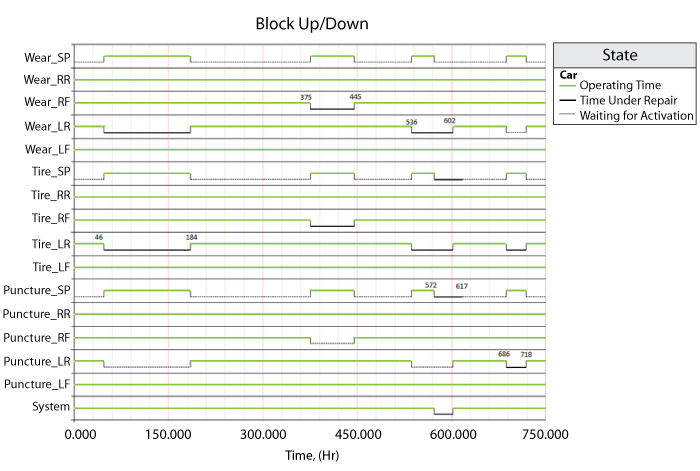Template:Tires
Tire Example
Description
A car has four regular tires and a spare tire. Each tire has two failure modes: Wear with Weibull distribution (Beta = 2,Eta = 40000 miles) and Puncture with Exponential distribution (Mean = 1year). Assume that 2 miles=1 hour. Both Wear and Puncture failures are repaired in two days. However, Wear is repaired as good as new, Puncture is repaired as bad as old. When regular tires fail, the spare tire is activated; upon regular tire is restored, the spare tire is deactivated ans put back.
BlockSim Solution
To model this system, six diagrams are created: Car, Tire_1, Tire_2, Tire_3, Tire_4 and Spare. Car is the main diagram. In the Car diagram, five subdiagram blocks Tire_1, Tire_2, Tire_3, Tire_4 and Spare are pointed to other five diagrams with the same names.
In diagram Car, subdiagram blocks Tire_1, Tire_2, Tire_3 and Tire_4 belong to maintenance group "Main Tires".
In diagram Tire_1, there are two blocks in series. Block Wear 1 represents Wear failure mode and Puncture 1 represents Puncture mode for tire 1 respectively. Block Wear 1 belongs to maintenance group "Wear_1" and Block Puncture 1 belongs to maintenance group "Puncture_1".
Block Wear 1 has State Change Triggers (SCT), its initial state is ON, and the state upon repair is "Always On". If any item from maintenance group "Puncture_1" goes down, deactivate this block and if any item from maintenance group "Puncture_1" is restored, activate this block. The reliability model for this block is Weibull distribution with Beta = 2 and Eta = 80000 hours. The corrective task duration is 2 days and the restoration is as good as new.
Block Puncture 1 also has State Change Triggers (SCT), its initial state is ON, and the state upon repair is "Always On". If any item from maintenance group "Wear_1" goes down, deactivate this block and if any item from maintenance group "Wear_1" is restored, activate this block. The reliability model for this block is exponential distribution with mean = 1 year. The corrective task duration is 2 days and the restoration is as bad as old.
Other three diagrams (Tire_2, Tire_3 and Tire_4) follow the same logic.
In diagram Spare, there are two blocks in series. Block Wear_S represents Wear failure mode and Puncture_S represents Puncture mode for spare tire respectively. Block Wear_S belongs to maintenance group "Wear_S" and Block Puncture_S belongs to maintenance group "Puncture_S".
Block Wear_S has State Change Triggers (SCT), its initial state is OFF, and the state upon repair is "Always OFF". If any item from maintenance group "Puncture_S" goes down, deactivate this block and if any item from maintenance group "Puncture_S" is restored, activate this block. If any item from maintenance group "Main Tires" goes down, activate this block and if any item from the maintenance group "Main Tires" is restored, deactivate this block. The reliability model for this block is Weibull distribution with Beta = 2 and Eta = 80000 hours. The corrective task duration is 2 days and the restoration is as good as new.
Block Puncture_S has State Change Triggers (SCT), its initial state is OFF, and the state upon repair is "Always OFF". If any item from maintenance group "Wear_S" goes down, deactivate this block and if any item from maintenance group "Wear_S" is restored, activate this block. If any item from maintenance group "Main Tires" goes down, activate this block and if any item from the maintenance group "Main Tires" is restored, deactivate this block. The reliability model for this block is Weibull distribution with Beta = 2 and Eta = 80000 hours. The corrective task duration is 2 days and the restoration is as bad as old.

